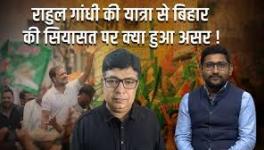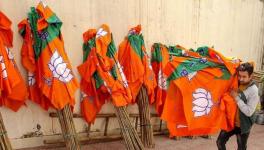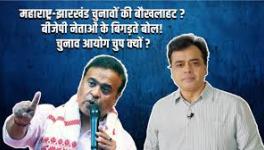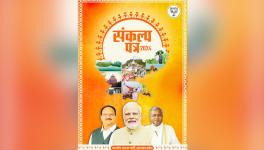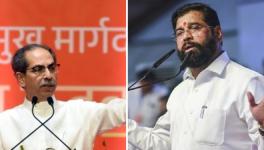Maharashtra is Latest State to Slip Away from Bungling BJP
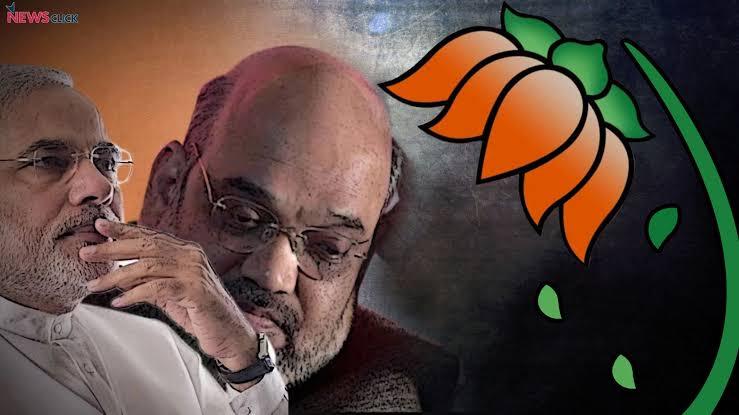
The Maharashtra standoff between 35-year old allies Bharatiya Janata Party (BJP) and Shiv Sena is not only about unbridled ambition and addiction to power. It is a product of the steady and relentless erosion of BJP’s support in state after state. As the three maps below show, after reaching its peak in 2017, BJP’s hold on power has notably gone down in state governments.
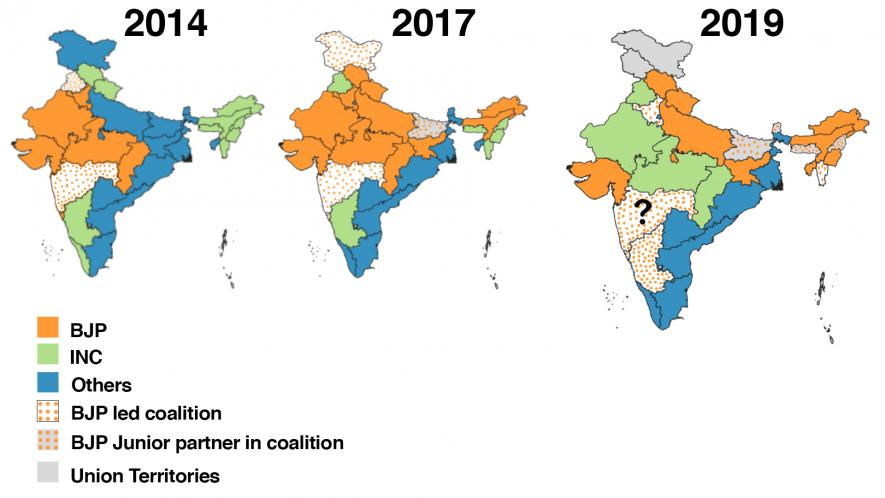
In Maharashtra, despite a pre-poll alliance, and despite winning a majority in the recent Assembly elections, things are worse than in 2014. A resurgent Shiv Sena is playing hardball seeing that BJP is on the ropes. If this imbroglio doesn’t get resolved by tomorrow, President’s Rule will have to be imposed because the term of the Assembly expires tomorrow. This is a dramatic comedown from just a month ago when the BJP was claiming that it will win a landslide victory.
Having already lost their majority in Haryana and been forced to join up with a fledgling Jananayak Janata Party (JJP) to retain power in the state, BJP’s fortunes are clearly on the decline. In many other states, it is power only by engineering defections or abandoning allies to join up with some other winning outfit.
In 2014, when Narendra Modi led BJP to victory at the Centre, the party was ruling on its own majority in just five major states -- Gujarat, Madhya Pradesh, Chhattisgarh, Rajasthan and Haryana. It was also in power in Maharashtra but only in coalition with Shiv Sena, and in Punjab, but only as a junior partner of the Akali Dal.
But then, due to the clout of Central government and the enormous money that it had mobilised, a sort of ‘saffron wave’ was whipped up. It won majorities in elections in Uttar Pradesh, Uttarakhand, Himachal Pradesh and Jharkhand.
In addition, it organised the defection of Nitish Kumar’s Janata Dal (United) from the Opposition to its own fold and thus started sharing power in Bihar. It brokered a deal with People’s Democratic Party in Jammu & Kashmir and came to power there, too, as a junior partner. And it organised wholesale defections in Arunachal Pradesh to form a government. In Goa, it formed an alliance with an opposition party to retain power.
So, by 2017, a combination of outright popular support in some states and, arm-twisting and horse-trading in others, saw BJP emerge as rulers across a wide swathe of the country. [See map above]
But, within two years since then, BJP first lost Madhya Pradesh, Chhattisgarh and Rajasthan, then it was thrown out of Punjab along with its ally, Akali Dal. It made fresh inroads in the North-East, winning outright in Tripura by aligning with a tribal outfit with separatist antecedents, and managing post-poll tie-ups and defections in some other states, such as Meghalaya and Nagaland.
But if you look at the map for 2019, the decline of BJP is striking. It is evident that the ground is steadily slipping away from under their feet.
Why is BJP Support Eroding?
BJP won the 2019 Lok Sabha elections handsomely, increasing both its vote share and its seats. Yet, it is losing state after state. What’s going on?
State governments have much less room for manoeuvrability than the Central government. They are largely dependent on Central funds, and this has become more pronounced under BJP rule. Most of the issues that directly impinge on daily lives of people are decided upon by state governments, be it land or law and order, or school education or primary healthcare or labour relations. Even Central government policies find direct expression in the impact on daily lives that people attribute to state governments.
Moreover, the BJP under Modi is also running a highly centralised system where all major decisions and initiatives are initiated and propagated by the Modi government itself. This dispensation ensures that it is Modi who gets all the credit for so-called welfare schemes. The state units of BJP – and their state governments – are mere postmen or couriers for the rulers in Delhi. At least, that is what is seen by the people.
So, it is natural that disastrous policies, like those related to agriculture or employment, are often equated with the most immediate power centre, that is, the state government.
All this has caused an increasing disillusionment with state governments run by BJP. The illusion that Modi and his distant government in Delhi is working hard for enhancing the status of the country and bringing in prosperity is still maintained.
However, the steady erosion of support for BJP in state governments is – or should be – a danger signal for the party top brass. The discontent and anger directed against its policies is today being expressed against state leaders; tomorrow it will coalesce against the central government, too.
As of now, the BJP leadership seems to be blithely unaware of this impending doom. That’s why the display of hubris and arrogance in Maharashtra.
Get the latest reports & analysis with people's perspective on Protests, movements & deep analytical videos, discussions of the current affairs in your Telegram app. Subscribe to NewsClick's Telegram channel & get Real-Time updates on stories, as they get published on our website.









